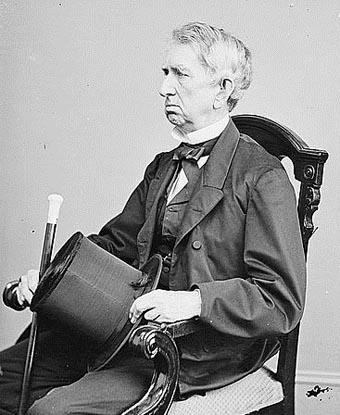Person
William H Seward

Library of Congress
William Henry Seward was appointed Secretary of State by Abraham Lincoln on March 5, 1861, and served until March 4, 1869. Seward carefully managed international affairs during the Civil War and also negotiated the 1867 purchase of Alaska.
Seward was born in Florida, New York on May 16, 1801. He graduated from Union College in Schenectady, New York in 1820.
William H. Seward became a well-established Republican politician, formerly identifying with the Whig Party, and was known for his stance against the spread of slavery. Many viewed him as the top Republican presidential candidate in 1860. Seward had a long political career including service in the New York State Senate, US Senate, and as governor of New York. Seward was so confident in the strength of his political experience that he believed it was nearly a foregone conclusion that he would secure the Republican nomination for President for the 1860 election. He was so confident in fact that he feared political overexposure was the only thing that could cost him the nomination.
In order to minimize this risk, in 1859, he embarked on an eight month tour of Europe. During this time the relatively unknown Abraham Lincoln campaigned aggressively and rapidly built up support amongst Republicans even as Seward's opinions became more moderate on the issue of slavery, costing him additional support. As a result, Lincoln was able to secure his nomination as the Republican Presidential candidate at the 1860 Republican Convention.
Once it was clear that Seward would not be the nominee, he dutifully put his support behind Lincoln, campaigning on his behalf. Because of his vast experience Seward was appointed Secretary of State in 1861. As the most powerful member of Lincoln's cabinet, Seward was part of many influential decisions, including the timing of the Emancipation Proclamation.
The timing of the proclamation was highly political. Lincoln penned his first copy in July 1862, when Union armies were losing one battle after another. Seward persuaded Lincoln that emancipation then would look like the "last measure of an exhausted government . . . stretching forth its hands to . . . Ethiopia, instead of Ethiopia stretching forth her hands to the government." (In the mid-19th century, black Americans were sometimes called Ethiopians.) So Lincoln decided to wait for a victory on the battlefield. The Battle of Antietam gave him his opportunity.
On the night of April 14, 1865 when John Wilkes Booth assassinated President Lincoln his actions were part of a coordinated plot to assassinate several high ranking members of the Lincoln administration. George Atzerodt was meant to murder Vice President Andrew Johnson, though he backed out at the last minute, while Lewis Powell and his lookout David Herold were sent to assassinate Secretary Seward. Seward was at home and bedridden following a recent carriage accident. Powell was able to gain entry to the home by saying that he had medicine for the Secretary. Once inside the home Powell attacked two of Seward's sons, soldier and nurse Sergeant George Robinson, and knocked Seward's daughter Fanny to the floor before brutally stabbing William H. Seward in the face and throat.
The attack left Seward with permanent facial scars, but he survived and continued to serve as Secretary of State in the Johnson administration. Perhaps his greatest achievement during this time, though it was commonly derided as "Seward's Folly", was helping to negotiate the purchase of Alaska from Russia in 1867.
